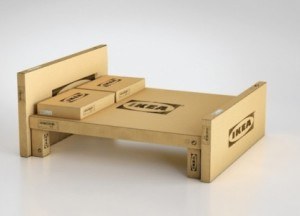The IKEA Concept: Furniture for the Masses

AKA, How to decorate your apartment on a student budget
The Backstory
IKEA was born in Sweden in 1943, founded by 17-year-old Ingvar Kamprad. Ingvar’s vision was to offer customers products they needed at reduced prices, and the original product offering included pens, wallets, and stockings.
Over 70 years later, IKEA has grown to include 361 retail locations across the globe and over 164,000 employees, and now primarily sells furniture and other homegoods. Despite the changes and growth over the past seven decades, the vision of offering customer quality products at prices the masses can afford has remained constant. IKEA’s business model today is this: sell high volumes of innovative home furnishings at affordable prices.
The Operating Model
Innovative Designs
To continually produce innovate designs, IKEA sources designs from a large network of freelance designers. By using freelance designers rather than a fixed employee base, IKEA can keep sourcing fresh, new ideas for their designs. Additionally, IKEA seeks designs that have global appeal – not only does this result in an interesting, international aesthetic, but also allows for lower manufacturing costs through standardization, compared to a model which has a greater number of SKUs.
Affordable Prices
To be able to offer their customers affordable prices, Ikea must in turn have an operating model that keeps their own costs low – from sourcing, to manufacturing and transportation, to selling the finished goods to customers. After sourcing the raw materials from suppliers, IKEA manages each stage in this supply chain, which allows for easy and transparent communication between steps, avoidance of the bullwhip effect, and a high degree of control over cost, quantity, and other aspects of production.
Beginning from the furthest point upstream, IKEA keeps their sourcing and raw material costs low by maintaining a network of over 1,800 suppliers across 50 countries. This allows them to take advantage of competition between suppliers, as well as adjust between countries to take advantage of currency or economic trends. Additionally, IKEA can leverage their size and large-volume orders to negotiate prices with suppliers. The tradeoff IKEA chooses is that with more suppliers, it is more challenging to maintain strong relationships and they may be losing out on some economies of scale, but they gain flexibility and competition driving down prices.
Once materials have been procured, IKEA manufactures their own furniture. IKEA practices what they call the “democratic design process”, wherein they manufacture ready-to-assemble furniture that customers build themselves, rather than fully assembled pieces. IKEA can then pack the finished goods in flat packages, which provides cost savings from decreasing transportation, packaging, and storage costs.
Finally, the packaged furniture is sold to customers in IKEA’s iconic retail locations. These blue-and-yellow havens, which represent a day of enjoyable shopping experiences for customers, represent additional cost-saving choices in IKEA’s operating model. The stores have minimal sales people, relying instead of a self-service model supplemented with very clear labels and signage. This reduces labor costs. IKEA usually locates their retail locations outside of major cities, where they can get lower real estate and rental costs. IKEA also makes efficient use of their retail space by reserving part of the stores for browsing, and the other part for warehousing and storage, where customers can retrieve items they’ve selected from the browsing area. This reduces the need for separate warehousing and storage facilities, and lowers transportation costs between storage and retail.
The Results
As a result of the strong alignment between IKEA’s business model of providing affordable furniture for the masses, and the operating model which achieves low costs, IKEA has experienced great success. IKEA has seen continually increasing revenues and stores, and last year, reported approximately $13 billion in profits.
Source: The Economist, February 24, 2011
Reductions in transportation, storage, and packaging from IKEA’s operating model has also helped them achieve their mission of doing right by the environment; IKEA reduced CO2 emissions by about 20% between 2010 and 2013. As of May 2015, IKEA was ranked #45 on Forbes’ list of most valuable brands with a brand value of $11.8 billion. And cost-conscious shoppers worldwide can live happily in their stylishly decorated homes.
Sources:
Annual Revenue of Ikea Worldwide, statista.com, December 1, 2015.
IKEA Cuts C02 Emissions by 19.3 Percent, greenretaildecisions.com, December 4, 2015.
IKEA History – How It All Began, ikea.com, December 3, 2015.
IKEA Retailing Facts and Figures, franchisor.ikea.com, December 3, 2015.
IKEA’s Inventory Management Strategy, tradegecko.com, December 2, 2015.
IKEA’s Low Price Strategy, cmuscm.blogspot.com, December 2, 2015.
The IKEA Concept, franchisor.ikea.com, December 1, 2015.
The Secret of IKEA’s Success, The Economist, December 4, 2015.
The World’s Most Valuable Brands, forbes.com, December 3, 2015.
Image sources:
About IKEA, ikea.com, December 3, 2015.
Employer Brand In Crisis?, Eremedia.com, December 3, 2015.
IKEA’s Inventory Management Strategy, tradegecko.com, December 2, 2015.







Thanks for this post! I’ve always been impressed by IKEA – smart customer niche selection aside, it’s managed to design an innovative, “fun” way to shop for furniture that’s added to its iconic brand. However, given the company’s financial success, I’m surprised there aren’t more companies that copy this model. The operating model described here seems decently replicable. What do you think are the barriers to entry?
Very interesting post about IKEA! But meanwhile I am a bit doubtful regarding their operation in local stores, especially the one in Boston that made so many unfortunate messes with the new RCs, myself included… Their delivery is full of mistakes, I have not heard from anyone whose delivery is completed at once without any wrong part, missing part, damaged part… My personal experience was even worse, I waited for 4 weeks to receive the bed frame and 6 weeks for the sofa bed. What I found out was that their internal communication was completely missing: aftersales hotline staffs could only communicate with local stores via emails, and only their supervisors are authorized to use phones and have phone numbers. Meanwhile, the local stores are not supposed to give any phone number to any customer – making my inquiry regarding the actual status of the delivery a complete mystery. I think this would not be the case if it were the special timing when all new Bostonians came to town. So what do you think about the flexibility of their operating model? And could they implement countermeasures facing such special timing that actually happens every year?
Thanks for your reply, Yubo! I had a similarly disastrous experience with an alternate furniture store, so I can certainly empathize. And your observation does not seem to be an outlier – CMO Leontyne Green acknowledges the inconsistencies in IKEA’s delivery in an article on Ad Age (see link below). It seems to be a more systemic issue than simply a peak demand time in Boston.
Why? I can’t give a definitive answer, but my hypothesis is this – IKEA’s core competencies in their operating model to center around standardization and low-cost manufacturing. Delivery to individuals is inherently a different service, and requires a larger amount of customization and specialized customer service. It may be worthwhile for IKEA to explore if delivery as a service fits their operating model and what has been their competitive advantage thus far, or if it’s better to leave delivery to other companies for whom customized service is a better fit.
Source: http://adage.com/article/cmo-interviews/ikea-cmo-leontyne-green-overhauling-perceptions/231336/
It was great to hear about how IKEA uses its supplier network as a source of strength. I would be intrigued to know more about how they manage all of those relationships given their strong control and high level of integration across the supply chain.
Great post, Andie!
As a big fan of Ikea, it was interesting to learn more about how they actually do it! I found the huge network of suppliers especially interesting, because we often consider vertical integration to be an operational boon. In this case, a spread out supply chain allows Ikea to maintain low cost. However, Ikea is also known for its sustainability and leading eco-friendly products. For example, they’ve gotten rid of formaldehyde in all of their lacquers. I imagine the disparate suppliers make those kinds of initiatives incredibly difficult to roll-out and enforce. While they don’t get to take advantage of in-house economies of scale, I think their huge network allows them to capture it in a different way. They’re such a big player, their suppliers don’t want to lose them!
Annie
Thanks for the post Andie! This is definitely a fun business.
It’s interesting that IKEA sources its designs through freelance designers. I wonder what that means in practice? This may just be the cynic in me, but it sounds like a way for IKEA to underpay designers. Given how subjective fashion and design can be, their freelance model probably allows them to pick and choose which design ideas they like and which ideas they dislike. This way, they only pay for good design ideas without paying for bad ideas. If IKEA held salaried designers on staff instead, they’d be paying for all their designers’ ideas, whether IKEA uses them or not. Given the high cost of Swedish labor, this makes great business sense, but I wonder if there are ethical implications.
Great post Julia! As a customer of Ikea’s I sometimes question their ability to compete in an increasingly online retail world. Given their low cost model, Ikea has under-invested in its online infrastructure.
In trying to purchase items for my Cambridge apartment while in New York, Ikea sent me on a wild goose chase. I wasn’t able to look into the Boston location’s inventory. I wasn’t able to arrange a delivery from that location. And when the items online were stocked out, I was added to the waitlist for a standard bedframe that took 3 months to fill. I was under the impression that all of these issues were resolved in the online retail space years ago!
I don’t mean to vent. I’m just questioning Ikea’s alignment of business+operating model in the world of online purchases. Given their low cost model, I’m not sure if investments into their online presence would align with their business strategy.
Sorry Andie! I just realized that I was looking at Julia’s post earlier and wrote her name in the comment box by accident.
Great post Andie! I am fascinated by how their operating model serves their business model of offering low-cost furniture. Part of that business model is transportation, I believe that IKEA believes in keeping transportation as a separate service from the furniture itself to an extent where they actually outsourced all of their delivery operations to third party agencies (@Yubo, this is possibly a reason why you didn’t receive an acceptable service). This way IKEA can focus on manufacturing low-cost furniture. In addition, a giant poster at IKEA-Stoughton lists the reason behind keeping delivery/transportation fees separate from furniture prices. The poster says that by keeping delivery fees separate we can guarantee that customers are not implicitly paying for transportation fees (when delivery price is bundled within the product price), and therefore serving the business model of maintaining affordability.